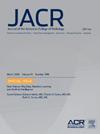Factors Influencing Radiologist Performance in the Merit-Based Incentive Payment System
IF 4
3区 医学
Q1 RADIOLOGY, NUCLEAR MEDICINE & MEDICAL IMAGING
引用次数: 0
Abstract
Purpose
The Merit-Based Incentive Payment System (MIPS) is the largest pay-for-performance program that links reimbursement to performance of Medicare clinicians. This study evaluated radiologist performance in the 2019 MIPS program and predictors of scores and underperformance.
Methods
Data were primarily from the CMS 2019 Quality Payment Program Experience Report. Multivariable linear and logistic regressions were conducted to identify factors associated with MIPS overall scores and with not reaching exceptional performance bonus status, respectively. An exploratory analysis of top 10 reported quality measures was performed.
Results
Among 22,875 radiology participants, 74.8% participated in group reporting, 4.3% as an individual and 20.9% through MIPS Advanced Payment Model (APM). The mean final score was 88.8, with 88.3% reaching exceptional status. Participation in a MIPS APM was associated with a 7.2-point (95% confidence interval [CI], 6.97-7.40) higher score compared with group reporting, and individual reporting was associated with a 28.3-point (95% CI, −30.12 to −26.54) lower score. Radiologists in practices of more than 500 clinicians had a 10.3-point (95% CI, 9.06-11.03) higher final score compared with those in practices of 10 or fewer clinicians. Similarly, radiologists participating as individuals or via smaller practices were less likely to achieve exceptional performance. The top 10 quality measures for group and individual reporting radiologists were all radiology related, whereas MIPS APM radiologists did not report any radiology-related measures.
Conclusions
Most radiologists performed successfully in 2019 MIPS, but success varied across numerous factors. Reporting type and practice size were most predictive of program performance. The results reveal potential biases that should be addressed in the MIPS program.
绩效激励薪酬制度下影响放射科医师绩效的因素。
目的:基于绩效的激励支付系统(MIPS)是最大的绩效支付计划,将报销与医疗保险临床医生的绩效联系起来。本研究评估了放射科医生在2019年MIPS项目中的表现,以及分数和表现不佳的预测因素。方法:数据主要来自CMS 2019年质量支付计划体验报告。进行多变量线性和逻辑回归,分别确定与MIPS总分和未达到卓越绩效奖金状态相关的因素。对报告的前10项质量措施进行了探索性分析。结果:在22,875名放射学参与者中,74.8%参加了团体报告,4.3%作为个人报告,20.9%通过MIPS高级支付模式(APM)报告。最终平均得分为88.8分,88.3%达到优异状态。与小组报告相比,参加MIPS APM的得分高7.2点(95%可信区间[CI], 6.97-7.40),而个人报告的得分低28.3点(95% CI, -30.12至-26.54)。超过500名临床医生执业的放射科医生的最终得分比10名或更少临床医生执业的放射科医生高10.3分(95% CI, 9.06-11.03)。同样,放射科医生以个人身份或通过较小的诊所参与,也不太可能取得优异的成绩。分组和个人报告放射科医生的前10项质量指标均与放射学相关,而MIPS APM放射科医生没有报告任何与放射学相关的指标。结论:大多数放射科医生在2019年MIPS中表现成功,但成功因多种因素而异。报告类型和实践规模是最能预测程序性能的。研究结果揭示了MIPS项目中应该解决的潜在偏见。
本文章由计算机程序翻译,如有差异,请以英文原文为准。
求助全文
约1分钟内获得全文
求助全文
来源期刊

Journal of the American College of Radiology
RADIOLOGY, NUCLEAR MEDICINE & MEDICAL IMAGING-
CiteScore
6.30
自引率
8.90%
发文量
312
审稿时长
34 days
期刊介绍:
The official journal of the American College of Radiology, JACR informs its readers of timely, pertinent, and important topics affecting the practice of diagnostic radiologists, interventional radiologists, medical physicists, and radiation oncologists. In so doing, JACR improves their practices and helps optimize their role in the health care system. By providing a forum for informative, well-written articles on health policy, clinical practice, practice management, data science, and education, JACR engages readers in a dialogue that ultimately benefits patient care.
 求助内容:
求助内容: 应助结果提醒方式:
应助结果提醒方式:


